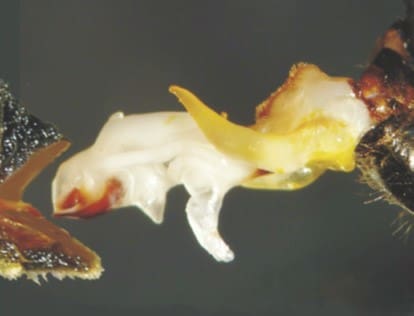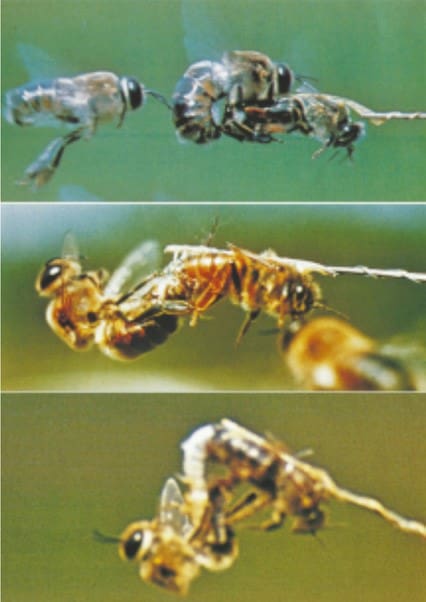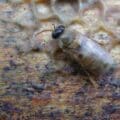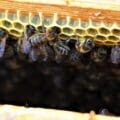Selection and reproduction
by Giacomo Acerbi
Drops of light… that carry words of love…
Maurice Maeterlink
… but my butterfly men
God, how far away they were
I watched them caress each other
make their rainbow
almost hard tenderness
grown on my breasts…
Mia Martini – butterfly men
In previous articles we have focused on ethology, biology, reproductive health factors of drones, therefore on the crucial role of these variables on fitness, performance and genetic evolution of bee colonies. The part that the male plays, both inside and outside the hive superorganism for which he has specialized over millions of years, is decisive for survival and selective strategy of the genus Apis. And it calls for a possible evolutionary interpretation of the biology of the drone, for which the relationships of cause and effect, randomness, adaptive capacity, are part, matrix and design of the ethology of the entire hive.
Relations… and copula, to say the least… Special
We left ourselves at the last stage of mating, the copula, the moment when in the fertilization comet, the drone grabs the young virgin and makes the ultimate sacrifice, to ensure the future of the species. Let us now return to the common and widespread perception that attributes the fulcrum of the reproductive behavior of bees to the queen bee. Beyond appearances and beliefs are instead and once again the drones to condition if not to determine a good part of the behaviors and vital phases of the young queen bees: from the timing of stay in the DCA, to the number of nuptial flights, from the success – or not – of the reproductive act, to the timing of the beginning of deposition.
“The Kiss”, Gustav Klimt 1907-08
Some queens are fertilized in a single nuptial flight, others in two, others in three or maximum in four flights (Roberts, 1944)

Who brings… trousers?
Virgin queens usually perform a reduced number of orientation flights, short and short, of maximum 2/5 minutes (Woyke, 2007), preparatory to the real wedding flights in the DCA (Koeniger, 2007). Fertilization flights on the other hand have a duration ranging from 3 minutes (shortest flight recorded) to 57 minutes (longest flight), with an average of between 15 and 30 minutes (Ruttner, 1964). Queens can make multiple consecutive bridal flights on the same day (up to seven) and for several consecutive days (Heidiger, 2014) to reach the DCAs typically at a distance of 1/2 km from their hive. They are fertilized by several drones in the same mating flight, averaging 8 (Woyke, 1960). A patrilinearity study on sperm, in a single nuptial flight, ascertained a range from 5 to 10 drones for single coupling (Franck, 2002). Temperatura, environmental conditions, age of the queen, distance from the Dca, concentration of drones in the neighboring DCAs… may affect the duration and frequency of flight activity of virgins. Typically, when the oviducts are filled with 120 million sperm, the queen returns to the hiveare. In the following twenty-four hours the process is carried outI know about 6 million – only! – of spermatozoa, through the spermatic duct, pass into the spermatheca. So the 95% of sperm are expelled via vagina (Woyke, 1988). Some queens fertilize into a single nuptial flight, others in two, others in three or maximum in four flights (Roberts, 1944). What makes queen bees already fruitful return to the DCA? To answer this question Woyke analyzed, in four years from 1960 to 1964, 2,434 flights of 628 queens. It turned out that 37% of thethe already fertile queens do not return to fertilize, while 63% do, but among these only 38% fertilize a seconfrom time and 8% a third time. this behavior is consequent to the amount of sperm acquired in the spermatheca. An adequate amount of semen in the oviducts, that allows the passage in the spermatheca of 5.3 million spermatozoa makes it so that no further fertilization is needed, 3.5 million spermatozoa instead are not enough, this pushes the queen to exit the hive again.
Limiting as much as possible the duration and frequency of the Queen’s flights is therefore a fundamental aspect of the bee’s survival strategy: predators, adverse weather, drift in other colonies, all this can have a very high cost for the colony, which often results in its death. The wedding flight should be as short as possible but with the necessary result (Koeniger 2007): and it is once again the drones that determine the behavior and choices of the young virgin queen bees. Already in 1964 Woyke had hypothesized that the queen reiterates nuptial flights, depending on the result of the last mating, that is, the amount of sperm or concentration of sperm contained in the spermatheca.
This thesis has been supported by subsequent studies, so the behavior of the queen depends on the outcome of the previous nuptial flight, since she is able to evaluate the result of the fertilization flight. An established fact is that the time of nuptial flight, with a large concentration of drones, is greatly reduced, with also a greater concentration of sperm in the oviducts (Koeniger, 2007). The possibility of multiple fertilization in the same nuptial flight is important for the reproductive strategy of bees (Koeniger, 2007): number, vigor, health, quality and vitality of the sperm of the drones, are not only basic elements, but also determine the choices and behavior of the bees.
Detail from “Botticelli’s Spring”
When the first drone manages to grab the virgin, in about two seconds it concludes the act (Koeniger, 2014), with then a succession of couplings for which in 16 seconds you can have up to 8 copulas

One of the hearts of the reproductive strategy of bees; “Post-mortem Cooperation”
Selective pressure and maximization of time and intensity of nuptial flight are peculiar evolutionary aspects of the genus Apis. In many insect species males use glandular secretions in the copula as a deterrent and inhibitor for competitors (Thornhill and Alcock, 1983). The drones instead emit glandular secretions to mark the queen and facilitate its recognition by the next drone: a phenomenon called “post-mortem cooperation”, aimed at optimizing time and quantity of couplings in nuptial flight (Koeniger, 1990). There is a huge variability in the number of matings a queen can Woyke in 1955 identified a difference in the volume of sperm contained in both oviducts ranging from 6 to 20 mm³. With therefore number of matings in a single nuptial flight from 1 to 15 males. What is it that determines, under the same environmental conditions, this variability in a single flight, from one to ten? What determines the end of a wedding flight? When the first drone manages to grab the virgin, in about two seconds it concludes the act (Koeniger, 2014), with then a succession of couplings for which in 16 seconds you can have up to 8 copulas. To explain this phenomenon, which is the heart of the reproductive strategy of bees, it is necessary, once again, to focus attention on the behavior of the drones – it is the failure of the male to remove the mating sign of his predecessor from the queen’s sting chamber, which determines the impossibility of carrying out further mating and the consequent cessation of nuptial flight.

“The Lovers”, René Magritte, 1928
In nature, in many species of insects males use glandular secretions in the copula as a deterrent and inhibitor for competitors. The drones instead emit glandular secretions to mark the queen and facilitate its recognition by the next male
In the event that the queen bee does not receive the sufficient amount of sperm and reaches its hive, it removes from itself or with the help of bees the sign of fertilization, and returns again to fertilize on the same day or in the following (Woyke, 2011). The sign of fertilization it normally consists of the chitinized plates of the endophallus of the kelp filled with mucus, with orange membranes that cover its sides and a protruding thin thread, which remains, visible, in the end of the abdomen of the queen (Woyke, 1955). The mating sign is always originated from two or more drones (Woyke, 2011) and is the consequence of a consecutive multiple fertilization. Progressive subversion of the endophallus of the kelp causes a traction of the coupling mark of the previous kelp outside the queen’s sting chamber: the plates of chitin and mucus come from the previous kelp but the orange membranes are of the drone that tried to remove it without success (Woyke, 2011); this is what it tells us that a subsequent male attempted to mate.

Photo taken from the study Not the honey bee (Apis mellifera l.) queen, but the drone determines the termination of the nuptial flight and the onset of oviposition, Jerzy Woyk – 2016 – Journal of Apicultural Science
Three stages of mating:
1) the kelp grabs the virgin and approaches the terminal part of the abdomen to the queen’s sting chamber,
2) the muscles of the abdomen of the kelp contract and the endophallus partially occurs,
3) complete eversion of the endophallus

The first birth and… its “moon”
Mode and number of matings also condition the timing of when the queen begins to lay: it is the capacity of the drones with which she mated, not the queen therefore, to determine the beginning of the egg laying. Part of the queen bees begin to lay on the eighth day of birth, others on the fourteenth. Typically due to the failure of a drone to remove the mating sign of the previous male, the queen bee has not received sufficient volume of sperm, and is therefore induced to perform one or more more nuptial flights (Woyke, 2008). Obviously the adverse weather conditions can affect the outcomes of fertilization and therefore the beginning of the egg laying of the queen, but what determines more fertilization flights and therefore the timing of starting the deposition of the young queen bee is often connected to the success or not of a drone in removing the mating sign of the previous male. On average, the number of drones fertilizing a queen bee in a single nuptial flight is between 7 and 10 (Wendel, 1958), and on average the failure to remove the mating sign is determined by the seventh to the tenth kelp which, in sequence, tries to fertilize the queen. The efficiency or otherwise of the drones in carrying out this removal may be due to anatomical factors and / or aspects of their reproductive health. On the other hand, different anatomical conformations of the sting chamber of the queens may or may not favor the copula.

“Hope II”, Gustav Klimt, 1907-08
Part of the queen bees begin to lay on the eighth day of birth, others on the fourteenth
Once again we verify how the kelp is much more and much more than just “flying sperm”, but ring crucial and fulcrum of the reproductive strategy, survival and evolution of bees. Even if they still escape the our understanding several aspects on the fertilization of bees, in the evolution of knowledge a protagonistands out with increasing importance: the drone is much more than a mere vehicle of genes to the offspring. Its value it goes far beyond and transcends the role that has been assigned to it for centuries by a limited and anthropocentric vision of the biology of bees. The quality of the males we raise, the their reproductive health, is undoubtedly the heart of the fitness and performance of our hives, of the success or failure of the zootechnical or selective strategies that they can be made by a beekeeping company. Both below the biological and genetic profile, the whole life and survival of bees revolves around behavior, collaboration strategies , mating dynamics of… drones!
MAIN REFERENCES




